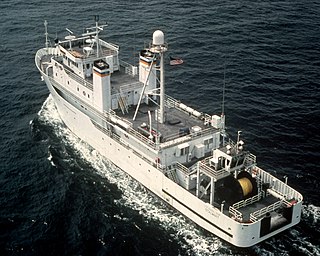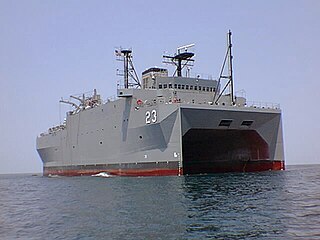
A small waterplane area twin hull, better known by the acronym SWATH, is a catamaran design that minimizes hull cross section area at the sea's surface. Minimizing the ship's volume near the surface area of the sea, where wave energy is located, minimizes a vessel's response to sea state, even in high seas and at high speeds. The bulk of the displacement necessary to keep the ship afloat is located beneath the waves, where it is less affected by wave action. Wave excitation drops exponentially as depth increases, so wave action normally does not affect a submerged submarine at all. Placing the majority of a ship's displacement under the waves is similar in concept to creating a ship that rides atop twin submarines.

Sea Shadow (IX-529) was an experimental stealth ship built by Lockheed for the United States Navy to determine how a low radar profile might be achieved and to test high stability hull configurations that have been used in oceanographic ships.

USNS Mizar (MA-48/T-AGOR-11/T-AK-272) was a vessel of the United States Navy. She was named after the star Mizar.

HMNZS Resolution (A14) was a hydrographic ship of the Royal New Zealand Navy (RNZN). Originally the United States Naval Ship USNS Tenacious (T-AGOS-17), the Stalwart-class ocean surveillance ship was used by the United States to locate and track Soviet submarines from 1989 to 1997, when she was transferred to the RNZN for use as a hydrographic survey ship. She served until 27 April 2012. She was subsequently sold to EGS Group, a private surveying company, and renamed RV Geo Resolution.

USNS Stalwart (T-AGOS-1) was a Modified Tactical Auxiliary General Ocean Surveillance Ship and the lead ship of her class.

Stalwart-class auxiliary general ocean surveillance ships (T-AGOS) are a class of United States Naval Ship (USNS) auxiliary support Ocean Surveillance Ships commissioned between April 1984 and October 2000. Their original purpose was to collect underwater acoustical information using the Surveillance Towed Array Sensor System (SURTASS), a towed array passive sonar.

The AN/UQQ-2 Surveillance Towed Array Sensor System (SURTASS), colloquially referred to as the ship's "Tail", is a towed array sonar system of the United States Navy.

USNS Triumph (T-AGOS-4) is a Stalwart-class ocean surveillance ship formerly of the United States Navy. She was struck from the Naval Vessel Register in 1995. On 1 October 2012 the ship was disposed of by Navy title transfer to the Maritime Administration. As of May 2015, Triumph was held as a reserve asset for spare parts for sister ships General Rudder and State of Michigan.

NRP Almirante Gago Coutinho (A523) is a ship of the Portuguese Navy' Dom Carlos I-class survey vessels. Before transfer to the Portuguese Navy, Almirante Gago Coutinho was formerly USNS Assurance (T-AGOS-5) of the United States Navy.

USNS Persistent (T-AGOS-6) was a Stalwart-class Modified Tactical Auxiliary General Ocean Surveillance Ship of the United States Navy.

Prevail (IX-537) is a modified Stalwart-class auxiliary general ocean surveillance ship (AGOS) of the United States Navy previously operated by the U.S. Military Sealift Command as T-AGOS 8. Prevail was reclassified as Unclassified Miscellaneous (IX) in October 2003 and is unofficially referred to as TSV-1. In this context, TSV stands for Training Support Vessel, and should not be confused with the U.S. Army's USAV Spearhead Theater Support Vessel initiative.

NRP Dom Carlos I (A522) is the lead ship of the Portuguese Navy's Dom Carlos I-class survey vessels adapted in Portugal for the execution of hydrography and oceanography surveys. Before the transference to the Portuguese Navy, Dom Carlos I was USNS Audacious (T-AGOS-11) surveillance ship of the United States Navy.

USNS Adventurous (T-AGOS-13) was a Stalwart-class modified tactical auxiliary general ocean surveillance ship of the United States Navy in service from 1988 to 1992. She was in non-commissioned service in the Military Sealift Command from 1988 to 1992, operating during the final years of the Cold War. She was transferred to the National Oceanic and Atmospheric Administration (NOAA) in 1992 and in 2003 was commissioned into service with NOAA as the fisheries research ship NOAAS Oscar Elton Sette.

The USNS Worthy (T-AGOS-14) was a modified Stalwart-class ocean surveillance ship operated by the United States Navy.

USNS Titan (T-AGOS-15) was a Stalwart-class modified tactical auxiliary general ocean surveillance ship in service in the United States Navy from 1989 to 1993. From 1996 to 2014, she was in commission in the National Oceanic and Atmospheric Administration (NOAA) fleet as the oceanographic research ship NOAAS Ka'imimoana.

USNS Capable (T-AGOS-16) was a Stalwart-class modified tactical auxiliary general ocean surveillance ship of the United States Navy in service from 1989 to 2004. In 2008, she was commissioned into service in the National Oceanic and Atmospheric Administration as the oceanographic research ship NOAAS Okeanos Explorer.

USNS Able (T-AGOS-20) is a Victorious-class oceanographic survey ship in the service of the United States Navy's Military Sealift Command.

USNS Victorious (T-AGOS-19) is a Victorious-class ocean surveillance ship which was acquired by the U.S. Navy in 1991 and assigned to the Military Sealift Command (MSC) Special Missions Program.

USNS Impeccable (T-AGOS-23) is an Impeccable-class ocean surveillance ship acquired by the U.S. Navy in 2001 and assigned to Military Sealift Command's Special Missions Program.



















